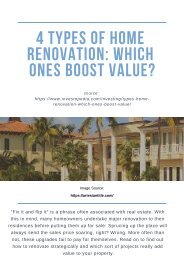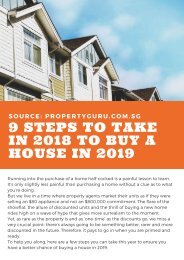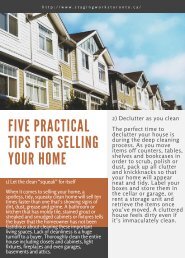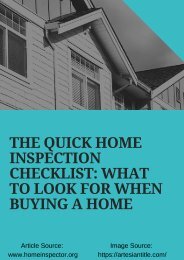How to Save Money to
Create successful ePaper yourself
Turn your PDF publications into a flip-book with our unique Google optimized e-Paper software.
H O W T O S A V E M O N E Y<br />
T O<br />
Buy a House<br />
ARTICLE SOURCE: www.everydollar.com<br />
IMAGE SOURCE: https://artesiantitle.com/
Buying a Home<br />
Saving<br />
<strong>How</strong> <strong>to</strong> <strong>Save</strong> <strong>Money</strong> <strong>to</strong> Buy a House<br />
Looking <strong>to</strong> buy a house? You'll need <strong>to</strong> save money for a<br />
down payment.<br />
What Is a Down Payment?<br />
Let’s start with the basics. A down payment is the cash<br />
you bring <strong>to</strong> the closing table when buying a home. You<br />
may borrow money from the bank in the form of a home<br />
loan or mortgage, but a portion of the <strong>to</strong>tal cost must<br />
come directly from you.<br />
Here’s why: The down payment acts as an insurance of<br />
sorts for your lender. When you hand over money from<br />
your own account, you’re officially invested. You’re more<br />
likely <strong>to</strong> make good on your mortgage payments month<br />
after month and year after year. Banks like working with<br />
folks like you.<br />
By saving up for a down payment, you not only prove<br />
yourself <strong>to</strong> a lender, but you also set your own mind<br />
at ease. A sizeable down payment reduces your<br />
monthly house payment, allowing you <strong>to</strong> choose a<br />
shorter mortgage term so you can say goodbye<br />
<strong>to</strong> this debt sooner rather than later.
<strong>How</strong> Much Should I <strong>Save</strong> for a Down Payment?<br />
It’s no secret that we don’t like debt. That’s because car loans, student loans<br />
and credit card debt can tie up our income, leaving us with less money for<br />
the things we really want <strong>to</strong> do.<br />
So how much should you save? That’s the million-dollar question! But don’t<br />
worry. You won’t need anything close <strong>to</strong> one million dollars <strong>to</strong> set yourself on<br />
the right track for buying a home. <strong>How</strong>ever, you do need <strong>to</strong> work through the<br />
process below <strong>to</strong> arrive at your magic number.<br />
We’ll use an imaginary family—the Clarks—in our example.<br />
1. Determine how much you can afford each month. The rule of thumb is <strong>to</strong><br />
spend no more than 25% of your monthly take-home pay on your mortgage<br />
payment. If you tie up <strong>to</strong>o much of your budget in your monthly payment,<br />
you leave yourself unprepared <strong>to</strong> face emergencies or embrace<br />
opportunities. We find that 25% (or less!) is the sweet spot.<br />
For the Clarks, 25% of their monthly take-home pay equals $1,050 each<br />
month. Keep in mind that this number should include taxes and insurance,<br />
escrow, and homeowner association fees.<br />
Do the math: Write down how much money you (and your spouse, if<br />
applicable) bring home each month. Multiple this number by .25 <strong>to</strong> find your<br />
monthly mortgage amount.<br />
2. Use your monthly mortgage payment <strong>to</strong> arrive at a <strong>to</strong>tal mortgage<br />
amount. Let’s play around with Dave Ramsey’s Mortgage Calcula<strong>to</strong>r <strong>to</strong> see<br />
what price range the Clarks should stick with.<br />
When it comes <strong>to</strong> the type of mortgage you select, we recommend a 15-year<br />
fixed rate, which is guaranteed <strong>to</strong> save you tens of thousands of dollars<br />
compared with the traditional 30-year option.<br />
We know the Clarks have $1,050 <strong>to</strong> spend on their monthly mortgage<br />
payment. Using the mortgage calcula<strong>to</strong>r and its set interest rate of 3.66%, we<br />
discover that they can purchase a $145,000 home with a 20% down payment,<br />
a $130,000 home with a 15% down payment, or a $125,000 home with a 10%<br />
down payment.<br />
Do the math: Spend some time on our mortgage calcula<strong>to</strong>r. Input different<br />
numbers in<strong>to</strong> the home value and down payment section with the goal of<br />
hitting your preferred <strong>to</strong>tal monthly payment. Make note of your options and<br />
talk things over with your spouse, a trusted friend or family member.<br />
3. Aim for between 10% and 20% for your down payment. If you haven’t<br />
already, hone in on the percentage that works best for your family. Ideally,<br />
you’ll choose <strong>to</strong> put down 20%, which can lower your interest rate, open you<br />
up for a 15-year mortgage, and help you avoid private mortgage insurance<br />
(PMI).<br />
Let’s assume the Clarks decide <strong>to</strong> put down 20% on a $145,000 home. That<br />
means they’ll need <strong>to</strong> set aside $29,000 for a down payment.<br />
Do the math: Multiply the <strong>to</strong>tal mortgage amount by the percentage you<br />
plan <strong>to</strong> put <strong>to</strong>ward the purchase of a home. Now you’ve got your savings<br />
goal! Circle it, post it on your fridge, and get ready <strong>to</strong> start saving!
What Other Costs Should I Consider When Saving for a Down<br />
Payment?<br />
Remember how we acknowledged that lenders aren’t exactly<br />
our best friends?<br />
Spoiler alert: Banks don’t just expect a down payment. They<br />
also require you <strong>to</strong> pony up for other fees that might feel<br />
hidden if you don’t know about them ahead of time. Let’s<br />
cover those now, shall we?<br />
Private Mortgage Insurance (PMI)<br />
Short for Private Mortgage Insurance, PMI is a fee tacked on<br />
<strong>to</strong> your monthly mortgage payment if you put down less than<br />
20% on your home. You can count on PMI upping your<br />
monthly payment by about $50 for every $100,000 you spend<br />
on a home.¹<br />
Appraisal and Inspection Fees<br />
In order for your lender <strong>to</strong> sign off on your mortgage, you’ll<br />
need <strong>to</strong> have your future home appraised and inspected. Each<br />
of these can cost just over $300 on average.²³<br />
Closing Costs<br />
A lot of work goes in<strong>to</strong> signing on the dotted line. And<br />
unless the seller agrees <strong>to</strong> pick up the tab, you’ll be<br />
responsible for fees between 2% and 5% of the <strong>to</strong>tal<br />
mortgage value.⁴

















